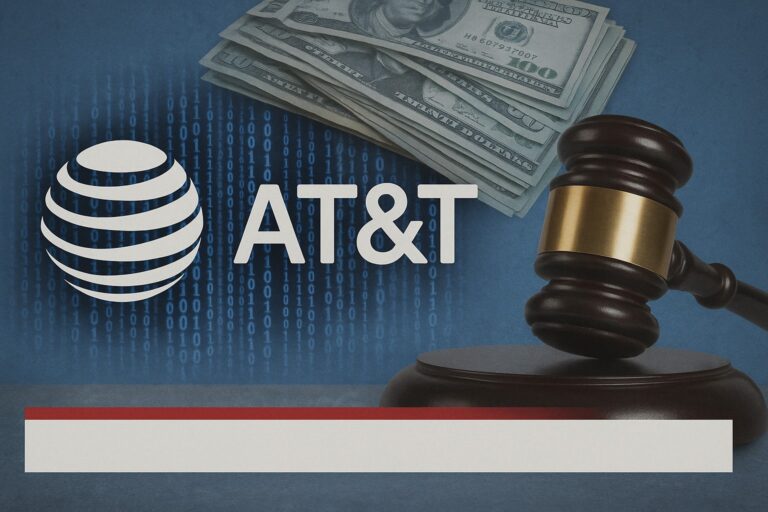When news broke that AT&T would pay $177 million to settle charges related to data breaches affecting millions of customers, many people likely wondered: “Where’s my check?” The reality is both simpler and more disappointing than most expect. This massive payout won’t result in individual compensation for affected customers, and understanding why reveals important truths about how corporate data breach settlements actually work.
What the $177 Million Settlement Actually Covers
AT&T’s settlement with state attorneys general addresses two separate data incidents that exposed sensitive customer information. The first, discovered in 2021, involved personal data of approximately 9 million customers being accessible through a third-party vendor. The second incident exposed calling and texting records of “nearly all” AT&T customers between May and October 2022.
Rather than going directly to customers’ pockets, the settlement money serves several specific purposes:
| Settlement Component | Purpose | Approximate Amount |
|---|---|---|
| State Government Funds | Compensation to state attorneys general offices for investigation costs | $135-140 million |
| Cybersecurity Improvements | Mandatory upgrades to AT&T’s data protection systems | $25-30 million |
| Compliance Monitoring | Third-party oversight and reporting requirements | $10-12 million |
Why Individual Customers Don’t Get Direct Payments
The Legal Structure of Regulatory Settlements
This AT&T case represents a regulatory enforcement action rather than a class-action lawsuit. When state attorneys general pursue companies for regulatory violations, the resulting settlements typically focus on systemic changes and deterrence rather than individual compensation.
“The goal isn’t necessarily to make consumers whole financially,” explains data privacy attorney Sarah Chen. “It’s to punish the company, fund better enforcement, and prevent future breaches through mandated security improvements.”
The Challenge of Proving Individual Harm
Unlike financial fraud where stolen money creates clear damages, data breaches present complex questions about individual harm. Most affected customers can’t point to specific financial losses directly caused by the breach. This makes individual compensation calculations extremely difficult and often impractical for large-scale settlements.
How Data Breach Settlements Typically Work
The Three Main Types of Data Breach Resolutions
1. Regulatory Settlements (Like AT&T’s)
- Government agencies pursue companies for regulatory violations
- Money goes to state treasuries and mandated improvements
- No direct customer compensation
2. Class Action Lawsuits
- Private attorneys represent affected customers
- Can result in individual payments (usually small)
- Often take years to resolve
3. Voluntary Customer Programs
- Companies proactively offer credit monitoring or identity protection
- Usually temporary services rather than cash payments
- Designed to maintain customer relationships
Why Class Actions Often Disappoint Too
Even when customers do receive individual payments through class-action settlements, the amounts are typically modest. Recent examples illustrate this pattern:
| Company | Settlement Amount | Affected Customers | Per-Customer Payout |
|---|---|---|---|
| Equifax | $700 million | 147 million | $0-$125 (most got $0) |
| Yahoo | $117.5 million | 3 billion | $25-$100 |
| $650 million | 1.6 million (Illinois only) | ~$400 |
What AT&T Customers Should Do Instead
Take Advantage of Available Protections
While you won’t receive a check, AT&T has typically offered affected customers free credit monitoring services and identity theft protection. These services, while not cash compensation, provide ongoing value that can exceed typical settlement payouts.
Monitor Your Accounts Actively
The most practical step involves implementing your own protection measures:
- Review credit reports regularly through annualcreditreport.com
- Set up fraud alerts with all three credit bureaus
- Monitor bank and credit card statements for unauthorized activity
- Consider credit freezes if you’re not actively applying for new accounts
The Bigger Picture: What This Settlement Means
Deterrent Effect on Corporate Behavior
While individual customers don’t see direct financial benefit, large settlements like AT&T’s serve important functions. $177 million represents a significant financial penalty that affects the company’s bottom line and sends signals to other corporations about the costs of inadequate data protection.
Funding Better Enforcement
Money flowing to state attorneys general offices helps fund future investigations and enforcement actions. This creates a cycle where settlement proceeds enable more aggressive pursuit of corporate data protection violations.
When Customers Might See Money
Separate Class Action Possibilities
The regulatory settlement doesn’t prevent private class-action lawsuits. Customers might still see individual compensation if private attorneys successfully sue AT&T over the same incidents. However, these cases face significant legal hurdles and can take years to resolve.
State Distribution Programs
Some states have created programs to distribute portions of large settlements directly to affected residents. While uncommon, a few states might establish such programs using their share of the AT&T settlement.
Protecting Yourself Going Forward
Understanding Your Rights
Data breach notifications should always include information about:
- What information was compromised
- What the company is doing to address the breach
- What protections are being offered to customers
- How to contact the company with questions
Building Personal Data Security Habits
Since you can’t control corporate data practices, focus on what you can control:
- Use unique passwords for different accounts
- Enable two-factor authentication wherever possible
- Limit personal information sharing with service providers
- Regularly review privacy settings on all accounts
The Bottom Line
AT&T’s $177 million settlement represents justice through systemic change rather than individual compensation. While this might feel unsatisfying to affected customers, the settlement’s real value lies in forcing better corporate behavior and funding stronger enforcement.
Rather than waiting for a check that likely won’t come, customers should focus on taking advantage of any offered protection services and implementing their own security measures. The unfortunate reality of data breaches is that prevention and personal vigilance offer more protection than post-incident settlements.
Understanding how these settlements work helps set appropriate expectations and emphasizes why pushing for stronger data protection laws and enforcement mechanisms ultimately serves consumers better than hoping for individual payouts after breaches occur.

